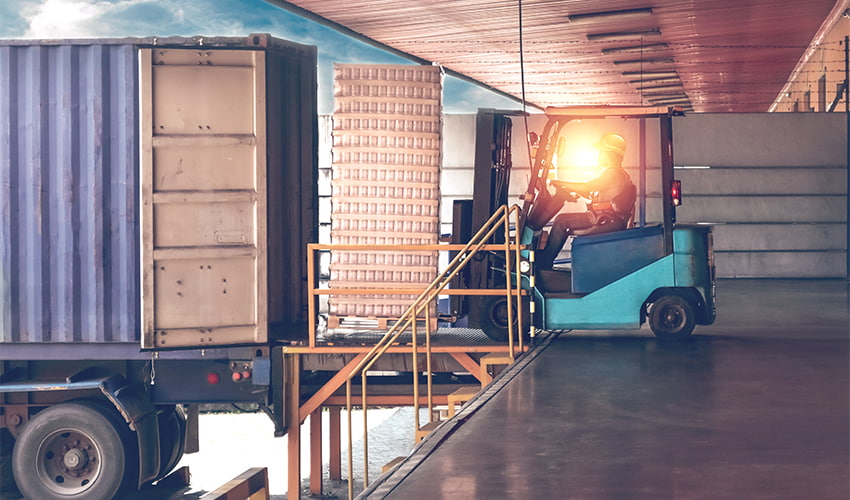An Essential Guide to DOT Load Securement Regulations

Are you aware of the DOT load securement rules that may apply to your fleet? Who is responsible for load securement?
Proper load securement guarantees the safe immobilization and transportation of cargo. Failure to comply with cargo securement regulations can result in serious repercussions. If bulky or heavy loads are not correctly secured, you risk damaging your vehicles and cargo, in addition to putting your drivers in unnecessary danger.
What is load securement?
The current DOT load securement regulations were first published by the Federal Motor Carrier Safety Administration (FMCSA) in 2002. Load securement is a blanket term covering all the factors you need to consider if your fleets transport heavy loads or pieces of equipment:
Securement systems
All parts of the vehicle that provide restraint against movement, including headboards, bulkheads, posts, steaks, and anchor points.
Securing devices
Any devices designed to hold your cargo in place on the trailer, including friction mats, chains, ropes, webbing, clamps, latches, binders, shackles, and hooks.
Tie-downs
The combination of securing devices that work together to attach and restrain the cargo to the trailer bed.
Working load limit (WLL)
The maximum safe force that can be applied to any component, as determined by the manufacturer.
Cargo securement rules
Responsibility lies with the motor carrier and the driver to ensure correct loading and security measures are followed. These are the main factors you need to consider to comply with DOT load securement.
Dimensions of vehicle + load
DOT loading regulations are based on knowing the precise dimensions of the equipment you are transporting. There must be no overhang once the trailer is loaded, and drivers should have clear visibility on all sides of the vehicle.
Weight of vehicle + load
The exact weight of your vehicle and the equipment you are transporting must be known entities. Otherwise, you cannot accurately combine the load weight with the vehicle weight and trailer to ensure you don’t exceed the gross combined weight rating (GCWR).
Capacity of your trailer
Aside from ensuring the GCWR does not breach DOT load securement regulations, you also need to make sure the trailer is sufficiently sturdy and capable of holding the weight of your cargo. This is essential for understanding the tie-down requirements for heavy equipment.
DOT tie-down requirements
The number and type of tie-downs you need will depend on the length, weight, and types of article (cargo) you carry. Here’s a breakdown of DOT strap requirements:
- Articles 5 feet long or shorter weighing 1,100 pounds or less, require only one tie-down.
- Articles 5 feet long or shorter weighing over 1,100 pounds require two tie-downs.
- Articles longer than 5 feet but shorter than 10 pounds require two tie-downs, regardless of weight.
- For articles longer than 10 feet, an additional tie-down is required for every 10-foot increment or part thereof.
- Articles weighing 10,000 pounds or more require tie-downs at all four corners.
- Wheeled or tracked vehicles over 10,000 pounds require four direct (anchor) tie-downs and tightening devices.
- The WLL from all tie-downs should be at least 50% of the weight of the cargo.
- Indirect tie-downs (none anchor) should be rigged at a minimum angle of 30 degrees to the deck.
- Edge protection is mandatory if a tie-down is at risk of abrasion where it touches an article of cargo.
- Booms must be lowered and properly secured – preferably with an additional tie-down device.
- Articles that are likely to roll require chocks, wedges, or a cradle.
- Articles placed side by side and secured with a transverse tie-down must be either in direct contact or prevented from shifting towards each other during transit.
- All drivers and loading bay personnel must have training in tie-down selection, use, and inspection.
Types of tie-downs
- Direct (anchor) tie-down: attaches directly from the trailer to the load
- Indirect (non-anchor) tie-down: leads threads over or through and connects back to the trailer
- Transverse tie-down: stretches over or through the load from one side of the trailer to the other
For clarification, a direct (anchor) tie-down attaches directly from the trailer to the load. An indirect (none anchor) tie-down leads threads over or through and connects back to the trailer. A transverse tie-down stretches over or through the load from one side of the trailer to the other.
Other cargo securement rules and DOT chain binder regulations you should know
Aside from the proper load securement procedures listed above, DOT regulations for load securement also include rules for transporting special purpose vehicles like heavy machinery and fabricated structural items. These must be fastened by special methods due to additional complexities caused by their size, shape, or weight.
There are also specific requirements for securing and transporting the following commodities:
- Logs
- Dressed lumber
- Metal coils
- Paper rolls
- Concrete pipes
- Intermodal containers
- Automobiles, light trucks, and vans
- Heavy vehicles, equipment, and machinery
- Flattened or crushed vehicles
- Roll-on/roll-off containers
- Large boulders
You can find a full breakdown on the DOT cargo securement webpage.
DOT compliance solutions
As you can see, DOT load securement regulations are complex. It’s best to find a fleet management solution to help you streamline compliance while also improving safety and productivity across your fleet.
At Lytx, we specialize in comprehensive fleet management solutions that make it easier to protect your vehicles, drivers, and cargo. Contact our team today to discuss your needs.

